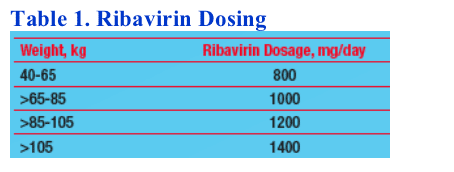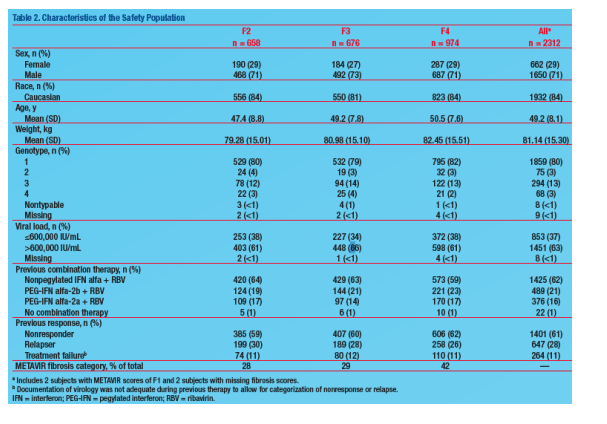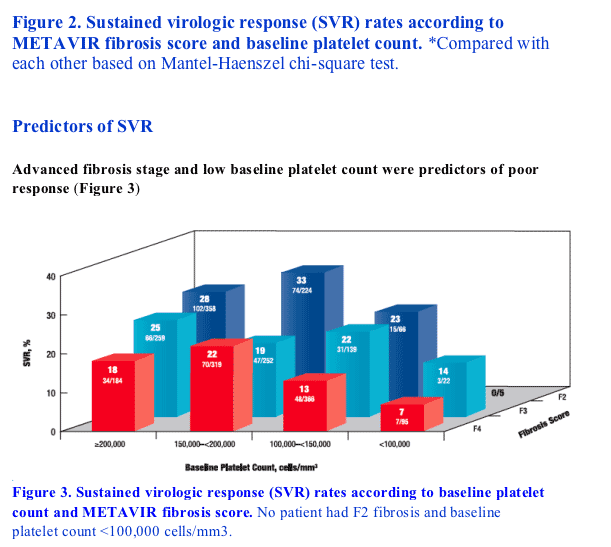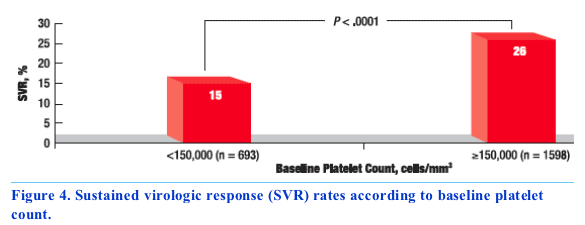 |
 |
 |
| |
Platelet Count (and fibrosis stage) Predicts Sustained Viral Response (SVR) in the Re-Treatment of Previous Interferon/Ribavirin (I/R) Non-Responders (NR):
Results from the EPIC3 Program
|
| |
| |
Reported by Jules Levin
43rd EASL
April 23-27, 2008
Milan, Italy
T. Poynard,1 E. Schiff,2 R. Terg,3 R. Moreno Otero,4 S. Flamm,5 W. Schmidt,6 T. Berg,7 G. Goncales Jr,8 J. Heathcote,9 M. Diago,10 T. McGarrity,11 P. Bedossa,12
W. Deng,13 P. Mukhopadhyay,13 L. Griffel,13 M. Burroughs,13 C. Brass,13 J. K. Albrecht13
1Groupe Hospitalier Pitie-Salpetriere, Paris, France; 2University of Miami School of Medicine, Miami, Florida, USA; 3Hospital Municipal de Gastroenterologia Dr Bonorino Udaondo, Capital Federal, Argentina; 4Hospital Universitario de la Princesa, Madrid, Spain;
5Northwestern University, Chicago, Illinois, USA; 6University of Iowa Hospitals and Clinics, Iowa City, Iowa, USA; 7Universitatsklinik Charite, Campus Virchow Klinikum, Berlin, Germany; 8Hospital das Clinicas da Unicamp Cidade Universitaria Zefirina Vaz, Campinas, Brazil;
9University Health Network, Toronto, Ontario, Canada; 10Hospital General Universitario de Valencia, Valencia, Spain; 11Milton S. Hershey Medical Center, Hershey, Pennsylvania, USA; 12Hpital Beaujon, Clichy, France; 13Schering-Plough Research Institute, Kenilworth, New Jersey, USA
This study EPIC assessed safety and efficacy of re-treatment with peginterferon a-2b 1.5 microgram/kg/wk subcutaneously plus Rebetol 800 1400 mg/day (P/R) for up to 48 weeks in subjects who failed previous treatment with any a-interferon plus ribavirin (I/R) to determine if platelet count levels are a predictor of SVR.
"Predictors of SVR: Advanced fibrosis stage and low baseline platelet count were predictors of poor response" see Figure 3 below
Author Summary
Overall, 22% of patients who were previously nonresponsive to any IFN alfa plus RBV therapy attained SVR when retreated with PEG-IFN alfa-2b plus RBV
- SVR rate increased to 56% if patients had undetectable HCV-RNA at week 12
Increasing stage of fibrosis and decreasing baseline platelet count were independent predictors of poor response
Baseline platelet count of 150,000 cells/mm3 was the best cutoff for predictability of response
Author Conclusions
Advanced fibrosis and low baseline platelet count are predictors of poor response to retreatment with PEG-IFN alfa-2b plus RBV in patients previously nonresponsive to any IFN alfa plus RBV combination therapy
Baseline platelet count <150,000 cells/mm3 may be a simple, robust, noninvasive predictor of SVR in this patient population
Abstract
Background and Aim: The likelihood of SVR in treatment-nave HCV patients correlates with degree of fibrosis. Since lower platelet levels correlate with advanced fibrosis, we explored the relation of platelet level with SVR using data from the EPIC3 program. This study assessed safety and efficacy of re-treatment with peginterferon a-2b 1.5 microgram/kg/wk subcutaneously plus Rebetol 800 1400 mg/day (P/R) for up to 48 weeks in subjects who failed previous treatment with any a-interferon plus ribavirin (I/R) to determine if platelet count levels are a predictor of SVR.
Methods: HCV NRs or those who relapsed after previous treatment with I/R who had significant fibrosis (METAVIR F2-F4) received PR. All patients had pre treatment biopsies scored by a single reviewer (P.B.) using METAVIR criteria. Plasma HCV-RNA was determined using a quantitative Taq-Man assay (SPRI; lower limit of detection 125 IU/mL).
Results:
Overall, 22% and 56% of those with undetectable HCV-RNA at TW 12, achieved SVR.
SVR decreased with increasing fibrosis. SVR rates also decreased with decreasing levels of baseline platelet counts (P<0.0001, Mantel-Haenszel chi square test).
In logistic regression analysis of SVR with genotype, previous response,
baseline viral load, previous therapy, baseline platelet count and fibrosis in the model, platelet count (P=0.0114) and fibrosis (P=0.0313) were independent predictors of poor response.
Odds ratios for attaining SVR for platelets ≥200,000 vs <150,000 cells/mm3 was 1.88, and for METAVIR F2 vs F4 fibrosis was 1.73, respectively.
Using regression-tree analysis 149,000 cells/mm3 was the best differentiator for SVR with 16% SVR for subjects with platelet counts <150,000 cells/mm3 (n=421)
and 26% SVR for ≥150,000 cells/mm3 (n=915); distribution of genotype was similar in these groups as was compliance to study drug.
Conclusions: Both advanced fibrosis and low platelet counts are predictors of poorer response to re-treatment in previous I/R treatment failures. Thrombocytopenia <150,000 cells/mm3 may be a simple, robust, non-invasive predictor of SVR with PegIntron/ribavirin therapy in previous NRs.
Note: Abstract has been updated since submission.
Background
Treatment of patients with chronic hepatitis C with pegylated interferon (PEG IFN) alfa plus ribavirin (RBV) results in overall sustained virologic response (SVR) rates of 54% to 56%1,2
Many host and viral factors, including fibrosis stage, baseline viral load, and hepatitis C virus (HCV) genotype, have been established as influencing treatment outcomes among treatment-naive patients with chronic hepatitis C
Multivariate analysis of data from several retreatment studies indicates that fibrosis stage is an accurate predictor of treatment outcome in patients who do not initially respond to therapy3-7
- The likelihood of SVR after retreatment of patients who were previously nonresponsive to therapy or who relapsed was 2.5 to 5 times greater among those with mild or moderate fibrosis than among those with bridging fibrosis or cirrhosis5,6
Platelet count has been used with other noninvasive diagnostic tools, such as the aspartate aminotransferase/platelet ratio index8 and a serum biomarker panel (FibroTest; BioPredictive, Paris, France),9 to assess fibrosis
- Such surrogate biomarkers of fibrosis may ultimately offer noninvasive alternatives to liver biopsy10
The Evaluation of PegIntron in Control of Hepatitis C Cirrhosis (EPIC3) program is an international, multicenter, open-label, single-arm, prospective study evaluating the retreatment of chronic hepatitis C patients with significant fibrosis or cirrhosis who were documented as having failed at least 12 weeks of therapy with any IFN alfaĞRBV combination therapy, comprising both conventional IFN alfa and PEG-IFN alfa.
Patients and Methods
Patients
Adult patients with chronic hepatitis C and significant fibrosis or cirrhosis (METAVIR F2, F3, or F4) who were documented as having failed at least 12 weeks of therapy with any IFN alfaĞRBV combination therapy, comprising both conventional IFN alfa and PEG-IFN alfa
Treatment
All patients received PEG-IFN alfa-2b (PegIntron¨; 1.5 _g/kg/wk) plus weight based RBV (800-1400 mg/day) for up to 48 weeks (Table 1)
-- Patients who did not respond (detectable plasma HCV-RNA) at treatment week 12 were withdrawn from this study at treatment week 18 and were able to enter 1 of 2 maintenance studies based on METAVIR score (Figure 1)

Primary Efficacy End Point and Assessments
· The primary end point of the study was SVR, defined as undetectable plasma HCV-RNA at the end of 24 weeks of follow-up
· Plasma HCV-RNA was determined at weeks 12, 24, and 48 of therapy and at 12 and 24 weeks after treatment cessation using a quantitative assay (TaqMan; Applied Biosystems, Foster City, CA; lower limit of detection for 95% sensitivity, 125 IU/mL)
- A subset of the samples tested at the Schering-Plough Research Institute Laboratory was sent for confirmatory testing to Quest Nichols Laboratory (San Juan Capistrano, CA)
· Patients were evaluated for tolerability and safety at treatment day 1, treatment weeks 2, 4, 8, 12, 24, 30, 36, 42, and 48, and follow-up weeks 4, 12, and 24
Results
Included in the primary safety population were 2312 patients (Table 2); 2293 of these patients were included in this analysis

Virologic Response Rates
Overall, 22% (823 of 2293) of patients attained SVR
- 56% (463 of 823) of patients with undetectable HCV-RNA at week 12 attained SVR
SVR rates decreased with advancing stage of fibrosis (Figure 2)
SVR rates also significantly (P < .0001) decreased with decreasing baseline platelet count (Figure 2)


Logistic Regression Analysis
With genotype, previous response, baseline viral load, previous therapy, baseline platelet count, and fibrosis score as factors, platelet count (P = .0014) and fibrosis score (P = .0011) were independent predictors of poor response
- Platelet count ≥200,000 cells/mm3 versus <150,000 cells/mm3: odds ratio = 1.80
- METAVIR F2 versus F4: odds ratio = 1.80
Regression Tree Analysis
Baseline platelet count of 150,000 cells/mm3 was the best cutoff for predictability of response
-- SVR rate was significantly lower in patients with baseline platelet counts <150,000 cells/mm3 (n = 693) than in patients with baseline platelet counts ≥150,000 cells/mm3 (n = 1598) (15% vs 26%, respectively; P < .0001) (Figure 4) Distribution of genotype and compliance with study drug were similar in these groups

References
1. Manns MP et al. Lancet. 2001;358:958-965.
2. Fried MW et al. N Engl J Med. 2002;347:975-982.
3. Shiffman ML et al. Gastroenterology. 2004;126:1015-1023.
4. Jacobson IM et al. Am J Gastroenterol. 2005;100:2453-2462.
5. Moucari R et al. J Hepatol. 2007;46:596-604.
6. Sherman M et al. Gut. 2006;55:1631-1638.
7. Poynard T et al. J Hepatol. 2005;42(suppl 2):40-41.
8. Parise ER et al. Liver Int. 2006;26:1095-1099.
9. Rossi E et al. Clin Chem. 2003;49:450-454.
10. Snyder N et al. J Clin Gastroenterol. 2006;40:535-542.
Supported by Schering-Plough Research Institute
|
| |
|
 |
 |
|
|